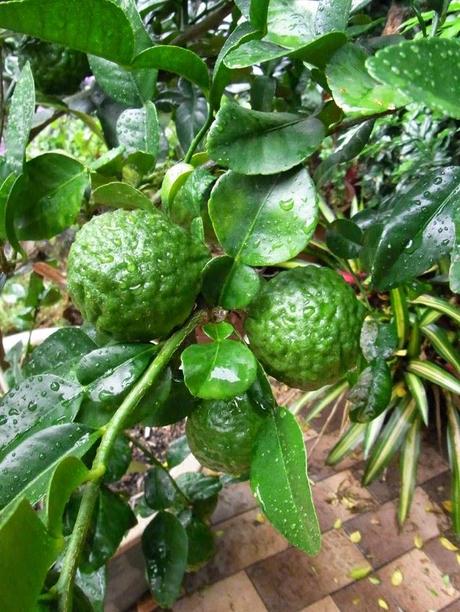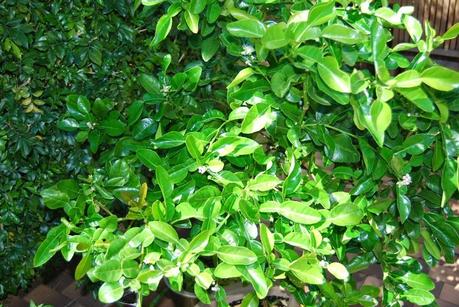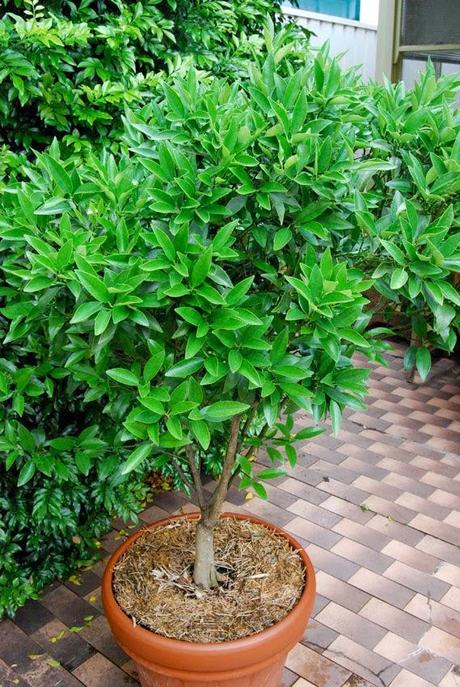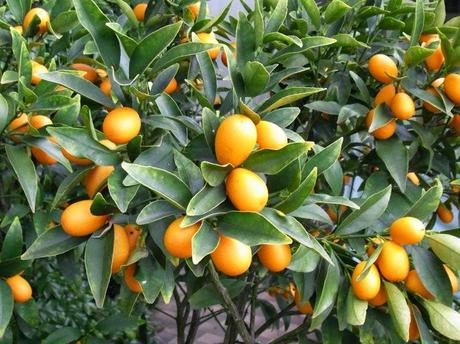After my last posting on feeding citrus, several readers have emailed, and 'Anne at Home' left a comment here, asking about feeding citrus in pots, so here's my combo-reply posting to all you potted citrus persons.
How often do you feed them? Aim for monthly if you can (and that is so much easier said than done. Remembering is the hard part. I try to remember to do it around the first weekend of every month, but even keen-as-mustard-me forgets sometimes.)

Happy Thai limes.

Happy Thai lime in a pot.
How much do you feed them? Not a lot. Light feeds are best.• For my "flinging in the rain" I used one handful of chicken poo, which is about 75 grams.
• If I use a liquid organic plant food, about one whole 9-litre can (made up according to the instructions on the pack) per month is plenty for my mature trees in big pots.
• If I use a slow-release food, I apply 3-4 tablespoons of pellets to a 45cm diameter pot, and that lasts 6 months (a good option over Sydney's mild winter, or if you're away travelling).
What do you feed them? Well, I like to mix it up a bit, but that's not essential. Over the last two years I have fed my potted citrus with:
Dynamic Lifter (organic chicken poo)
Dynamic Lifter Plus (for citrus, organic chicken poo with fruiting and flowering additives)Osmocote for Fruit and Citrus (slow-release granules, lasting six months per application)
Powerfeed organic-based liquid food for fruit and flowers
Nitrosol organic-based liquid food
The reason for the mixing up of foods is mostly that was what was in my shed at the time, and all of them work fine, so for convenience's sake I just used whatever was there.

Our former cumquat tree, now happily
domiciled at Louise and Antonio's place.

Essential ingredient for cumquat marmalade!
A little bit of potted citrus whys and hows...It's not just potted citrus that need to be fed more often, but lightly. It's everything in pots. Each time you water a pot, some of the potting mix's nutrients are washed away, out through the drain hole. Eventually all potting mixes completely run out of nutrients, and plants then might start to get unhappy (although some plants are more fussy than others, and citrus are world-class fuss-pots).
So, the big tip is that you need to constantly replenish a potted plant's food supply with little doses of food. Once a month is dandy.
That's why slow-release foods like Osmocote are so excellent for pots. They were originally designed (in California) for potted plants, with the special coating around each little pellet formulated so it releases its doses of nutrients more readily during warm and moist weather (when plants grow best) and releasing its nutrients more slowly when it is cool and dry (when plants grow slowest).
Furthermore, slow-release potted plant foods have the added advantage that you don't have to apply them so often. Depending on the product, they can last either three, six or 12 months. The Osmocote for citrus lasts 6 months.
The only drawback to slow-release foods is that they are not organic. They are just very sophisticated and extremely useful modern chemical plant foods.
However, if you want your garden to be an organic one, especially your food garden, then I suggest the easiest organic food to apply is the liquid type, where you mix up a capful of concentrate in a can of water, and apply that to the pot. For a mature potted citrus tree, one whole can of 9-litres is plenty for a potted citrus in a big (45cm or more diameter) pot. If you have a smaller baby citrus tree in a pot, use your common sense and halve that amount, maybe even cut it down to one-third. (Mix up a whole can at a time, though, as the leftover liquid foods are great for any flowering food plant, from cucumbers to capsicums, tomatoes to zucchinis, etc etc).
Hope this helps. Just remember, with the old saying about organic plant foods: "If it doesn't smell bad, then it's not organic!"
